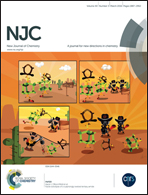Evaluating the role of electron-correlation in the external prediction of the toxicity of nitrobenzenes towards Tetrahymena pyriformis†
Abstract
The role of dynamic interactions between electrons (the electron-correlations) in the prediction of inhibitory growth concentration of alkyl- and halogen-substituted nitrobenzenes against Tetrahymena pyriformis is analyzed through the quantitative structure–activity relationships (QSARs) based on the widely used quantum-chemical descriptors. The advanced semi-empirical and ab initio quantum-mechanical methods are employed for the computation of the descriptors and their electron-correlation contribution. The statistical quality of the proposed QSAR models is assessed through the state-of-the-art external validation parameters via employing an external prediction set of compounds. This study revealed that the models based on the quantum-chemical descriptors incorporating mainly the effect of dynamical electron-correlation are significantly robust and externally predictive, in particular, the models based on the electron-correlation energy are found to be highly reliable. Besides this, the electron-correlation contributions to the orbital energies and to the electrophilicity index are also observed to be significant. The present work emphasizes that the biological activities of chemicals are significantly influenced by the “correlated” motion of electrons in the molecule.



 Please wait while we load your content...
Please wait while we load your content...